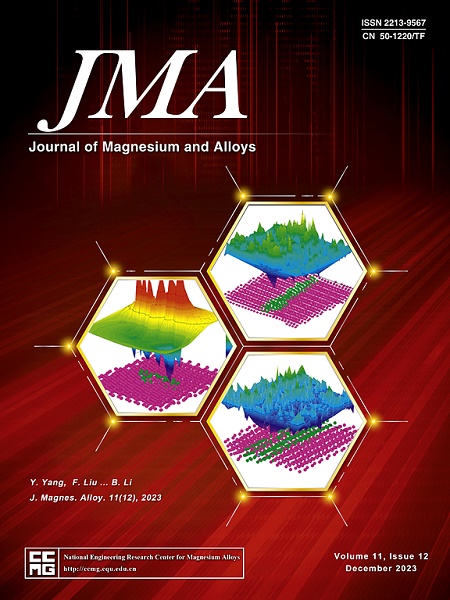Metallic glass-coated composite polyethylene terephthalate artificial ligament with enhanced mechanical and frictional wear properties
IF 15.8
1区 材料科学
Q1 METALLURGY & METALLURGICAL ENGINEERING
引用次数: 0
Abstract
Gadolinium (Gd) and yttrium (Y) elements were added to the composition design and sputtering process to create a composite artificial ligament with enhanced mechanical and frictional wear performance. Due to the oxidative and adhesive wear mechanisms, MgZnCaY metallic glass (MG) films exhibit a reduced scratch depth, a lower friction coefficient, and better wear resistance than MgZnCaGd. The wear coefficients of MgZnCaGd and MgZnCaY are 1.45 ± 0.04 and 0.99 ± 0.068, respectively. MgZnCaY MG coating has a higher hardness (8.64 ± 0.01 GPa) and Young's modulus (144.67 ± 1.57 GPa) than MgZnCaGd MG coating (4.90 ± 1.86 GPa, 110.4 ± 23.2 GPa). The MgZnCaY composite-coated artificial ligament has 49.02 MPa and 18.54% elongation at break, compared to 49.86 MPa and 15.19% for the MgZnCaGd coating. The results of the mechanical test shows that the coated composite artificial ligament allows for greater fracture elongation and appropriate stiffness during the stretching process. Because of the formation of Y2O3, which can strengthen the interfacial bonding strength between the adhesive layer and the ligament matrix, increase the adherence of oxides, and reduce the likelihood of oxide delamination, artificial ligaments coated with MgZnGaY also perform exceptionally well mechanically. The current research findings provide new insights for the design of composite artificial ligaments and present promising materials for applications in the field of artificial ligaments.

金属玻璃涂层复合聚对苯二甲酸乙二醇酯人工韧带具有增强的机械和摩擦磨损性能
在材料设计和溅射过程中加入钆(Gd)和钇(Y)元素,制备出具有增强机械和摩擦磨损性能的复合人工韧带。由于氧化磨损和黏着磨损机制,MgZnCaY金属玻璃(MG)薄膜比MgZnCaGd具有更小的划痕深度、更低的摩擦系数和更好的耐磨性。MgZnCaGd和MgZnCaY的磨损系数分别为1.45±0.04和0.99±0.068。MgZnCaY MG涂层的硬度(8.64±0.01 GPa)和杨氏模量(144.67±1.57 GPa)均高于MgZnCaGd MG涂层(4.90±1.86 GPa、110.4±23.2 GPa)。MgZnCaY复合涂层的人工韧带断裂伸长率为49.02 MPa和18.54%,而MgZnCaGd涂层的断裂伸长率为49.86 MPa和15.19%。力学试验结果表明,涂层复合材料人工韧带在拉伸过程中具有较大的断裂伸长率和适当的刚度。由于Y2O3的形成,可以增强粘合层与韧带基体之间的界面结合强度,增加氧化物的粘附性,降低氧化物分层的可能性,因此MgZnGaY涂层的人工韧带的机械性能也非常好。这些研究成果为复合人工韧带的设计提供了新的思路,并为人工韧带领域的应用提供了有前景的材料。
本文章由计算机程序翻译,如有差异,请以英文原文为准。
求助全文
约1分钟内获得全文
求助全文
来源期刊

Journal of Magnesium and Alloys
Engineering-Mechanics of Materials
CiteScore
20.20
自引率
14.80%
发文量
52
审稿时长
59 days
期刊介绍:
The Journal of Magnesium and Alloys serves as a global platform for both theoretical and experimental studies in magnesium science and engineering. It welcomes submissions investigating various scientific and engineering factors impacting the metallurgy, processing, microstructure, properties, and applications of magnesium and alloys. The journal covers all aspects of magnesium and alloy research, including raw materials, alloy casting, extrusion and deformation, corrosion and surface treatment, joining and machining, simulation and modeling, microstructure evolution and mechanical properties, new alloy development, magnesium-based composites, bio-materials and energy materials, applications, and recycling.
 求助内容:
求助内容: 应助结果提醒方式:
应助结果提醒方式:


